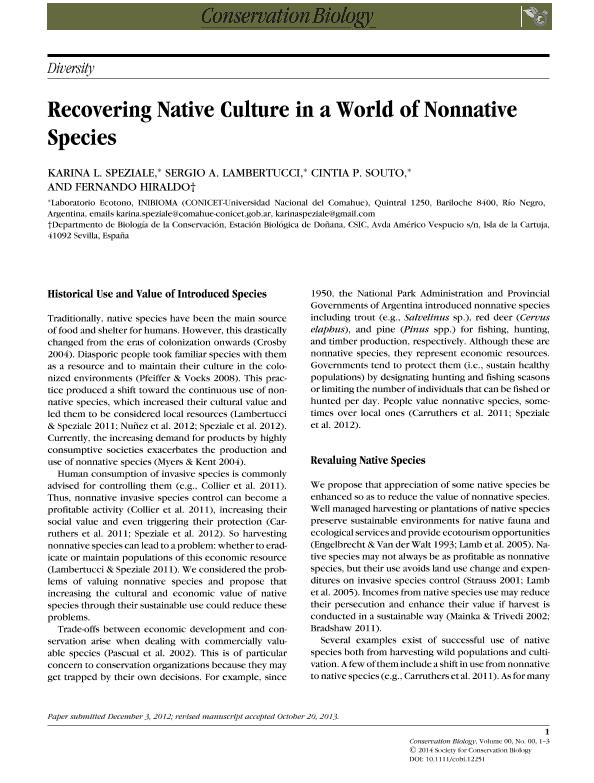Mostrar el registro sencillo del ítem
dc.contributor.author
Speziale, Karina Lilian

dc.contributor.author
Lambertucci, Sergio Agustin

dc.contributor.author
Souto, Cintia Paola

dc.contributor.author
Hiraldo, Fernando

dc.date.available
2017-11-06T16:53:58Z
dc.date.issued
2014-02-13
dc.identifier.citation
Speziale, Karina Lilian; Lambertucci, Sergio Agustin; Souto, Cintia Paola; Hiraldo, Fernando; Recovering native culture in a world of non-native species; Wiley Blackwell Publishing, Inc; Conservation Biology; 24; 4; 13-2-2014; 1129-1131
dc.identifier.issn
0888-8892
dc.identifier.uri
http://hdl.handle.net/11336/27656
dc.description.abstract
The positive feedback between biotic homogenization and its close relatives, cultural and culinary homogenization, is evident and favors the economic use of non-native species. The overvaluation of non-native species has not been thoroughly considered in conservation practices. There are few examples of a shifting strategy from producing exotic species to the productive use of native ones, and this change should be encouraged. However, several examples of sustainable use of native species exits. Here we call attention to more conscientious practices that gradually realign local needs with native natural resources. The revaluing of local diversity so that it is appreciated as in former times over a small number of globally used (non-native) species can be a key step in efforts to preserve native natural and cultural resources.
dc.format
application/pdf
dc.language.iso
eng
dc.publisher
Wiley Blackwell Publishing, Inc

dc.rights
info:eu-repo/semantics/openAccess
dc.rights.uri
https://creativecommons.org/licenses/by-nc-sa/2.5/ar/
dc.subject
Native Vs Exotic Species
dc.subject
Sustainable Use
dc.subject
Biotic Homogenization
dc.subject
Natura And Curtural Resources
dc.subject.classification
Bioquímica y Biología Molecular

dc.subject.classification
Ciencias Biológicas

dc.subject.classification
CIENCIAS NATURALES Y EXACTAS

dc.title
Recovering native culture in a world of non-native species
dc.type
info:eu-repo/semantics/article
dc.type
info:ar-repo/semantics/artículo
dc.type
info:eu-repo/semantics/publishedVersion
dc.date.updated
2017-08-09T14:05:55Z
dc.journal.volume
24
dc.journal.number
4
dc.journal.pagination
1129-1131
dc.journal.pais
Reino Unido

dc.journal.ciudad
Londres
dc.description.fil
Fil: Speziale, Karina Lilian. Consejo Nacional de Investigaciones Científicas y Técnicas. Centro Científico Tecnológico Conicet - Patagonia Norte. Instituto de Investigaciones En Biodiversidad y Medioambiente. Universidad Nacional del Comahue. Centro Reg.universidad Bariloche. Instituto de Investigaciones En Biodiversidad y Medioambiente; Argentina
dc.description.fil
Fil: Lambertucci, Sergio Agustin. Consejo Nacional de Investigaciones Científicas y Técnicas. Centro Científico Tecnológico Conicet - Patagonia Norte. Instituto de Investigaciones En Biodiversidad y Medioambiente. Universidad Nacional del Comahue. Centro Reg.universidad Bariloche. Instituto de Investigaciones En Biodiversidad y Medioambiente; Argentina
dc.description.fil
Fil: Souto, Cintia Paola. Consejo Nacional de Investigaciones Científicas y Técnicas. Centro Científico Tecnológico Conicet - Patagonia Norte. Instituto de Investigaciones En Biodiversidad y Medioambiente. Universidad Nacional del Comahue. Centro Reg.universidad Bariloche. Instituto de Investigaciones En Biodiversidad y Medioambiente; Argentina
dc.description.fil
Fil: Hiraldo, Fernando. Estación Biológica de Doñana, Departamento de Biología de la Conservación; España
dc.journal.title
Conservation Biology

dc.relation.alternativeid
info:eu-repo/semantics/altIdentifier/url/http://onlinelibrary.wiley.com/doi/10.1111/cobi.12251/abstract
dc.relation.alternativeid
info:eu-repo/semantics/altIdentifier/doi/http://dx.doi.org/10.1111/cobi.12251
Archivos asociados
